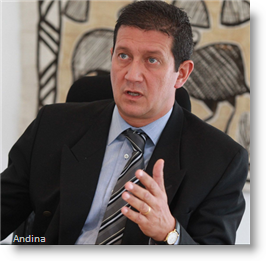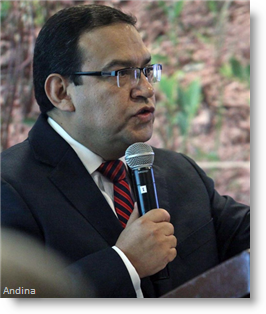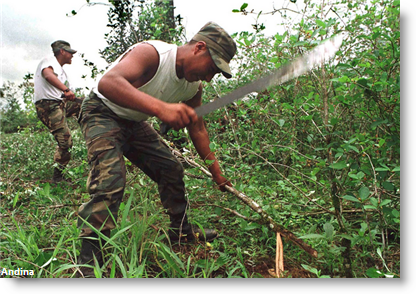 Peru reduced its territory used for growing coca leaves for a third straight year, according to an annual report from the United Nations Office on Drugs and Crime.
Peru reduced its territory used for growing coca leaves for a third straight year, according to an annual report from the United Nations Office on Drugs and Crime.
The UN said that 42,900 hectares of land were used to grow coca in Peru last year, down 14% from 2013. That is the lowest level since 1998, when Peru had 38,700 hectares under cultivation, according to the UN.
“It is an important achievement,” the UNODC’s representative in Peru, Flavio Mirella, said when releasing the findings on Wednesday.
The report found that Peru produce 100,840 tons of dry coca leaf in 2014, down 17% from 2013. About 10% of the coca grown in Peru is legal, used for traditional purposes such as chewing or drinking as a tea for digestion and  to ward off altitude sickness. The rest of production, however, goes towards making cocaine.
to ward off altitude sickness. The rest of production, however, goes towards making cocaine.
Peru’s coca production had increased steadily from the early 2000s to 2011, when more than 60,000 hectares were used to grow the crop. Peru was considered the world’s top cocaine producer, ahead of Colombia, where production had fallen sharply during the past decade, and Bolivia, the other major producer of the leaf.
Last year’s fall, coupled with a 17% decrease in 2013, means that Colombia likely overtook Peru as the biggest cocaine producer on earth.
“At this moment, we can say that Peru is not the world’s top producer of cocaine,” said Alberto Otarola, the head of the country’s antidrug agency, Devida.
Colombia’s coca production soared last year, with the amount of territory used to produce the leaf climbing about 44%, the UN said recently. That increase was due, in part, to pressure on farmers to increase their crops by the FARC rebels in order to gain more benefits from the government if a peace deal is reached, according to some analysts.
 Peru’s advances, meanwhile, have been due to increased eradication. Last year, the government ripped out more than 30,000 hectares of coca bushes, an annual record. President Ollanta Humala’s government has been steadily increasing eradication since he took office in 2011. Before, the government would eradicate about 10,000 hectares per year.
Peru’s advances, meanwhile, have been due to increased eradication. Last year, the government ripped out more than 30,000 hectares of coca bushes, an annual record. President Ollanta Humala’s government has been steadily increasing eradication since he took office in 2011. Before, the government would eradicate about 10,000 hectares per year.
The success in reducing coca has been particularly impressive in the Upper Huallaga Valley. That valley, located in north-central Peru, used to be Peru’s top coca growing region, with about 17,000 hectares under cultivation in 2009. Last year, only about 1,500 hectares were used to grow coca in the Upper Huallaga.
The decline there is possible due to the government’s dismantling of the Shining Path rebels that operated in the zone. In 2012, state security forces captured Florindo Flores, alias Comrade Artemio, the rebel group’s leader in the Upper Huallga, which paved the way for eradication and alternative development programs.
The other coca valley with a Shining Path faction is the broad area in southern Peru within the Apurimac, Ene and Mantaro River Valleys, an isolated montane forest zone known strategically as the VRAEM that includes territory in the Ayacucho, Huancavelica, Cuzco and Junin regions.
Despite Peru’s national decline, production stayed steady in the VRAEM, where the government has called off plans to eradicate due to security concerns. About 19,000 hectares were used to grow coca in the VRAEM, representing almost 44% of the national territory. However the area is so densely planted with the leaf that almost 70% of Peru’s total coca production now comes from the area.





